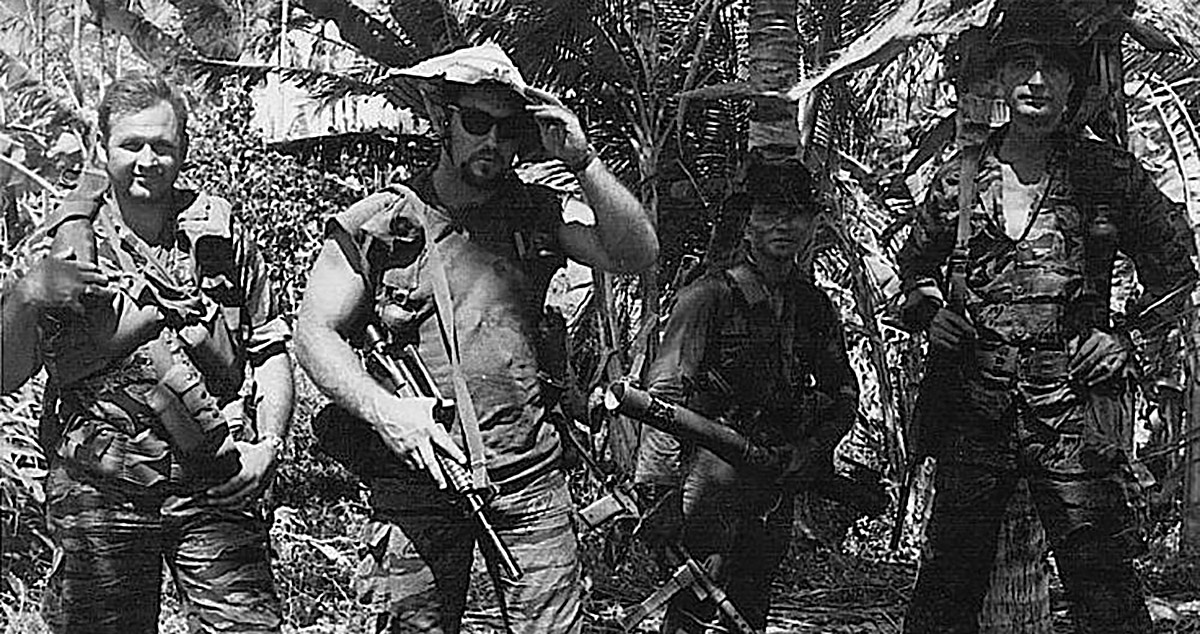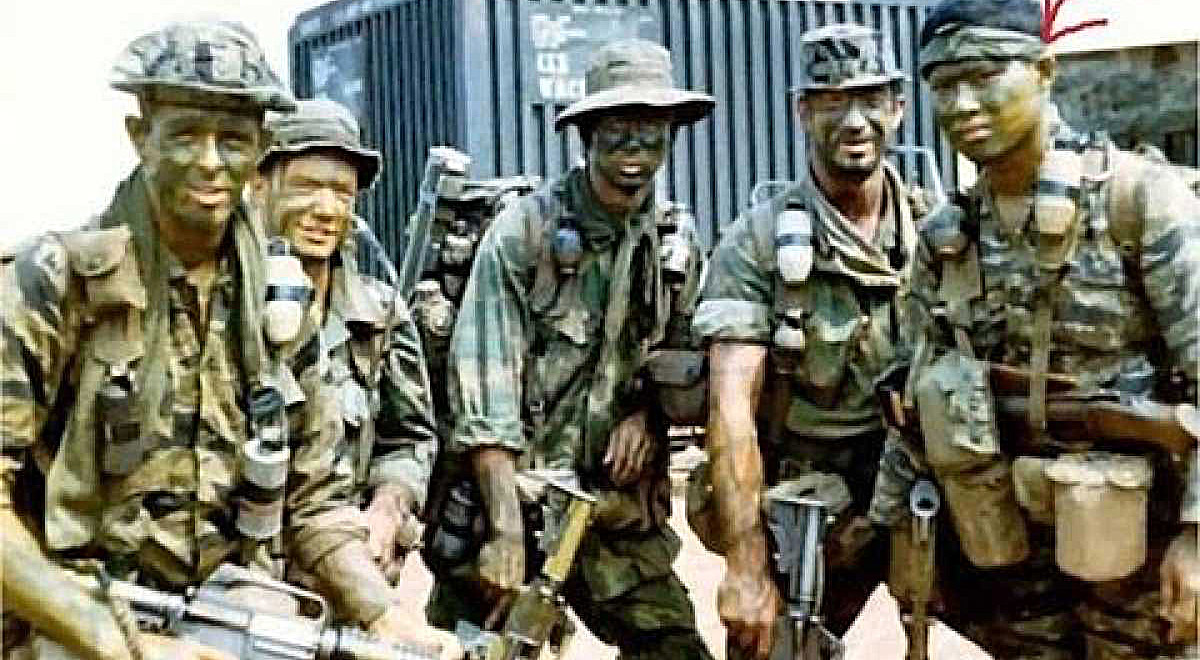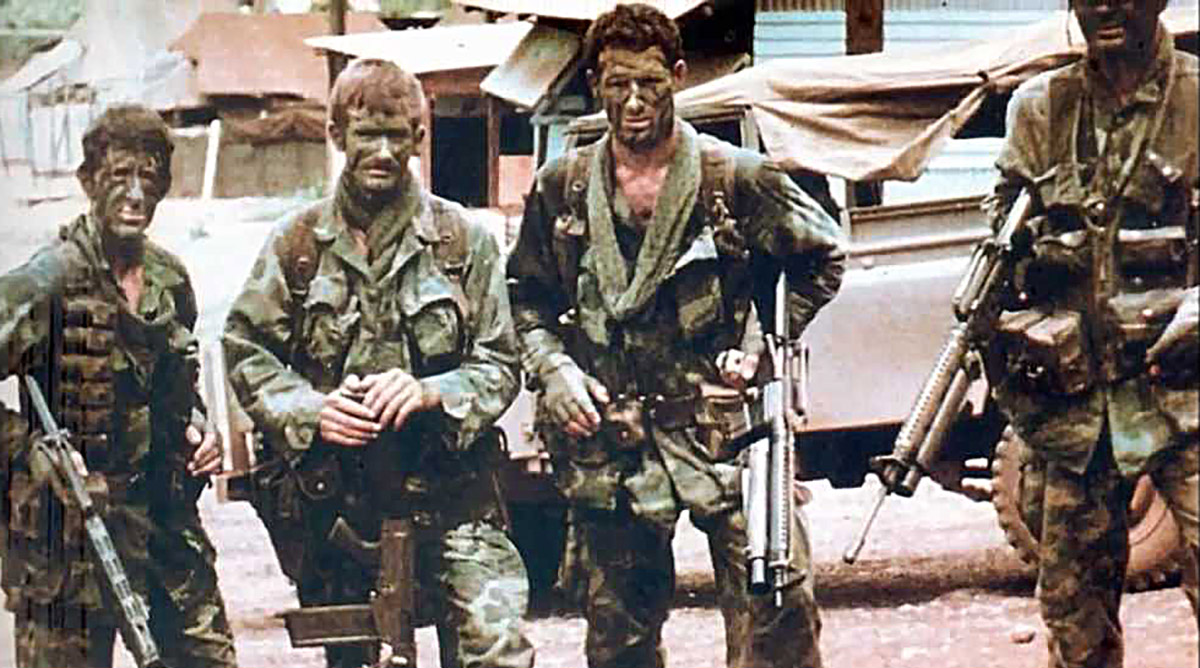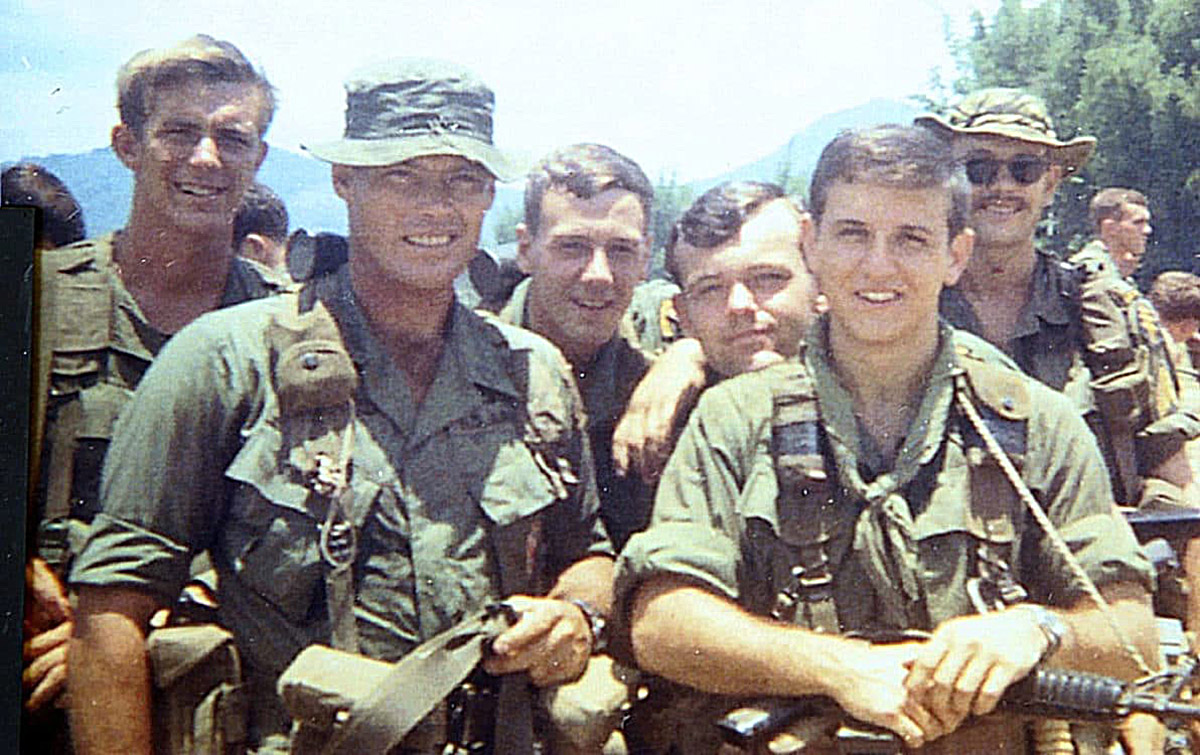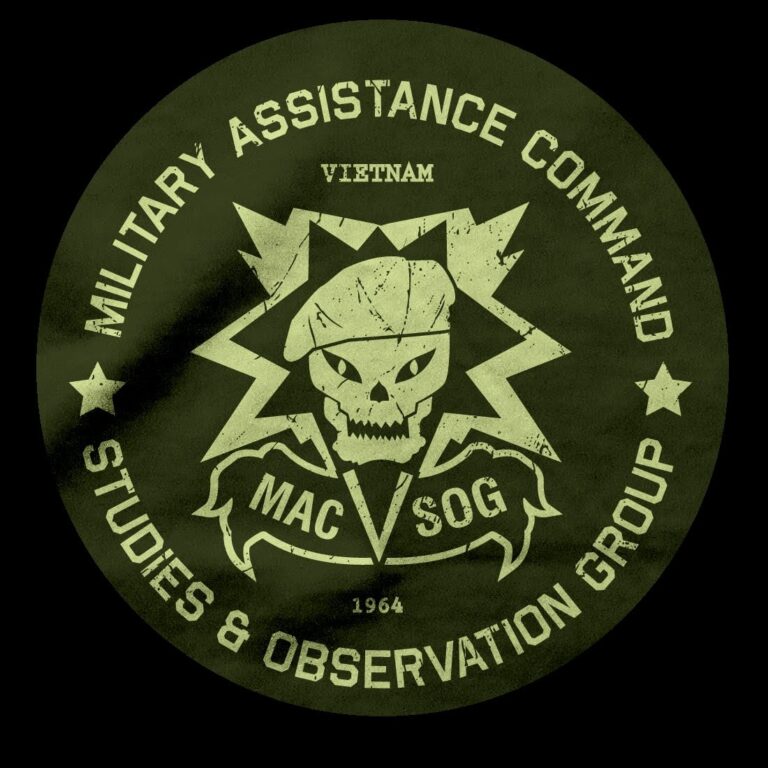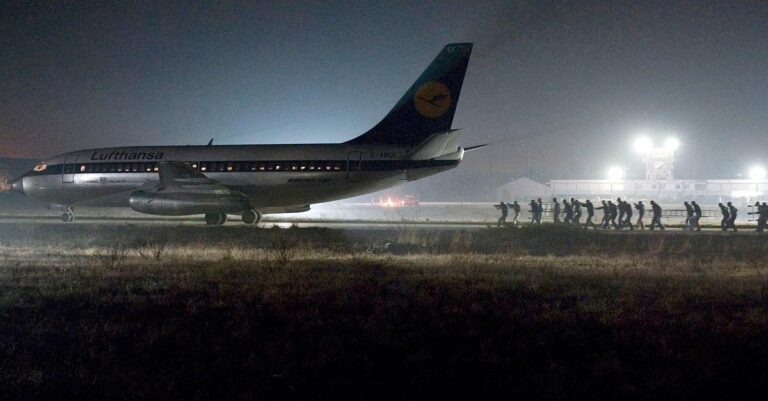SOG – Our story begins in Vietnam
Our story begins in Vietnam, where members of a highly classified US special ops unit – known as MACV-SOG – carried a unique combat knife into the jungle on covert missions. Years later, in 1986, that knife inspired a young designer, named Spencer Frazer, to found SOG Specialty Knives. His mission: to reproduce the original SOG Bowie knife and pay tribute to the special ops unit that created it. What began as a single commemorative model soon became a full line of innovative tools – field-proven by US Special Forces, even honored as the Navy SEAL knife of choice. Today, SOG knives are carried with confidence into the most demanding situations. Forged out of tradition, hardened in the field, honed for you.
So whether you’re protecting others or leading an epic hunting expedition, tackling one of life’s everyday challenges or facing your most extreme conditions yet, lead the way with SOG.
Military Assistance Command, Vietnam – Studies and Observations Group (MACV-SOG) was a highly classified, multi-service United States special operations unit which conducted covert unconventional warfare operations prior to and during the Vietnam War.
Established on 24 January 1964, the unit conducted strategic reconnaissance missions in the Republic of Vietnam (South Vietnam), the Democratic Republic of Vietnam (North Vietnam), Laos, and Cambodia; carried out the capture of enemy prisoners, rescued downed pilots, conducted rescue operations to retrieve prisoners of war throughout Southeast Asia, and conducted clandestine agent team activities and psychological operations.
The unit participated in most of the significant campaigns of the Vietnam War, including the Gulf of Tonkin incident which precipitated increased American involvement, Operation Steel Tiger, Operation Tiger Hound, the Tet Offensive, Operation Commando Hunt, the Cambodian Campaign, Operation Lam Son 719, and the Easter Offensive. The unit was downsized and renamed Strategic Technical Directorate Assistance Team 158 on 1 May 1972, to support the transfer of its work to the Strategic Technical Directorate of the Army of the Republic of Vietnam – part of the Vietnamization effort.
The Studies and Observations Group (also known as SOG, MACSOG, and MACV-SOG) was a top secret, joint unconventional warfare task force created on 24 January 1964 by the Joint Chiefs of Staff as a subsidiary command of the Military Assistance Command, Vietnam (MACV). The unit would eventually consist primarily of personnel from the United States Army Special Forces, the United States Navy SEALs, the United States Air Force (USAF), the Central Intelligence Agency (CIA), and elements of the United States Marine Corps Force Reconnaissance units.
The Studies and Observation Group (as the unit was initially titled) was in fact controlled by the Special Assistant for Counterinsurgency and Special Activities (SACSA) and his staff at the Pentagon. This arrangement was necessary since SOG needed some listing in the MACV table of organization and the fact that MACV’s commander, General William Westmoreland, had no authority to conduct operations outside territorial South Vietnam. This command arrangement through SACSA also allowed tight control (up to the presidential level) of the scope and scale of the organization’s operations. The mission of the organization was to execute an intensified program of harassment, diversion, political pressure, capture of prisoners, physical destruction, acquisition of intelligence, generation of propaganda, and diversion of resources, against the Democratic Republic of Vietnam.
These operations (OPLAN 34-Alpha) were conducted in an effort to convince North Vietnam to cease its sponsorship of the Viet Cong (VC) insurgency in South Vietnam. Similar operations had originally been under the purview of the CIA, which had carried out the emplacement of agent teams in North Vietnam using airdrops and over-the-beach insertions.
Under pressure from Secretary of Defense Robert S. McNamara, the program, along with all other agency para-military operations, was turned over to the military in the wake of the disastrous Bay of Pigs Invasion operation in Cuba.
Colonel Clyde Russell (SOG’s first commander) had difficulty in creating an organization with which to fulfill his mission since, at the time, United States Special Forces were unprepared either doctrinally or organizationally to carry it out. At this point the mission of the Special Forces was the conduct of guerrilla operations behind enemy lines in the event of an invasion by conventional forces, not in the conduct of agent, maritime, or psychological operations. Russell expected to take over a fully functional organization and assumed that the CIA (which would maintain a representative on SOG’s staff and contribute personnel to the organization) would see the military through any teething troubles. His expectations and assumptions were incorrect. The contribution of the South Vietnamese came in the form of SOG’s counterpart organization (which used a plethora of titles, finally ending with the Strategic Technical Directorate [STD]).
After a slow and shaky start, the unit got its operations underway. Originally, these consisted of a continuation of the CIA’s agent infiltrations. Teams of South Vietnamese volunteers were parachuted into the north, but the majority were captured soon after their insertions. Maritime operations against the coast of North Vietnam picked up after the delivery of Norwegian-built “Nasty” Class Fast Patrol Boats to the unit, but these operations also fell short of expectations.
On the night of 30–31 July 1964, four SOG vessels shelled two islands, Hon Me and Hon Ngu, off the coast of North Vietnam. This was the first time SOG vessels had attacked North Vietnamese shore facilities by shelling them from the sea. The following afternoon, the destroyer USS Maddox began an electronic intelligence-gathering mission along the coast of North Vietnam, in the Gulf of Tonkin. On the afternoon of 2 August, three P 4-class torpedo boats of the Vietnam People’s Navy came out from Hon Me and attacked the Maddox. The American vessel was undamaged, and the U.S. claimed that one of the attacking vessels had been sunk and that the others were damaged by U.S. carrier-based aircraft. On the night of 3–4 August, three SOG vessels shelled targets on the mainland of North Vietnam. On the night of 4 August, after being joined by the destroyer USS Turner Joy, Maddox reported to Washington that both ships were under attack by unknown vessels (assumed to be North Vietnamese).
2 August 1964: A North Vietnamese P-4 under fire from Maddox.
This second reported attack led President Lyndon B. Johnson to launch Operation Pierce Arrow, an aerial attack against North Vietnamese targets on 5 August. Johnson also went to the United States Congress that same day and requested the passage of the Southeast Asia Resolution (better known as the Gulf of Tonkin Resolution) asking for the unprecedented authority to conduct military actions in Southeast Asia without a declaration of war.
Johnson’s announcement of the incidents involving the destroyers did not mention that SOG vessels had been conducting operations within the same geographic area as the Maddox immediately before, and during, that cruise. Neither did he mention that on 1 and 2 August Laotian aircraft, flown by Thai pilots, had carried out bombing raids within North Vietnam itself or that a SOG agent team had been inserted into the same relative area and had been detected by the North Vietnamese. Hanoi, which may have assumed that all of these actions signaled an increased level of U.S. aggression, decided to respond (in what it claimed as its territorial waters), Thus, the three P-4s were ordered to attack the Maddox. The second incident, in which Maddox and Turner Joy were claimed to be attacked, never took place. Although some confusion reigned at the time of the second attack, the facts were clear to the administration by the time it went to Congress to obtain the resolution. When confronted by Senator Wayne Morse (who had discovered the existence of SOG’s 34-Alpha raids), McNamara lied to him, stating “Our Navy played absolutely no part in, was not associated with, and was not aware of any South Vietnamese actions.” Yet both Commander in Chief, Pacific Command (CINCPAC) and he were well aware of the possible connections, at least insofar as they might have existed in the minds of the Hanoi leadership. These events were not disclosed until the publication of the Pentagon Papers in 1970.
The last aspect of SOG’s original missions consisted of psychological operations conducted against North Vietnam. The unit’s naval arm picked up northern fishermen during searches of coastal vessels and detained them on Cu Lao Cham Island off Da Nang, South Vietnam (the fishermen were told that they were, in fact, still within their homeland). The South Vietnamese crews and personnel on the island posed as members of a dissident northern communist group known as the Sacred Sword of the Patriot League (SSPL), which opposed the takeover of the Hanoi regime by politicians who supported the People’s Republic of China (PRC). The kidnapped fishermen were well fed and treated, but they were also subtly interrogated and indoctrinated in the message of the SSPL. After a two-week stay, the fishermen were returned to northern waters.
This fiction was supported by the radio broadcasts of SOG’s “Voice of the SSPL”, leaflet drops, and gift kits containing pre-tuned radios which could only receive broadcasts from the unit’s transmitters. SOG also broadcast “Radio Red Flag,” programming purportedly directed by a group of dissident communist military officers also within the north. Both stations were equally adamant in their condemnations of the PRC, the South and North Vietnamese regimes, and the U.S. and called for a return to traditional Vietnamese values. Straight news, without propaganda embellishment, was broadcast from South Vietnam via the Voice of Freedom, another SOG creation.
These agent operations and propaganda efforts were supported by SOG’s air arm, the First Flight Detachment. The unit consisted of four heavily modified C-123 Provider aircraft flown by Nationalist Chinese aircrews in SOG’s employ. The aircraft flew agent insertions and resupply, leaflet and gift kit drops, and carried out routine logistics missions for SOG.
Since his election in 1968, President Richard M. Nixon had been seeking a negotiated settlement to the Vietnam War. In 1970, he saw an opportunity to buy time for the Saigon government during Vietnamization, the phased withdrawal of U.S. troops that began in the previous year. He also sought to convince Hanoi that he meant business. That opportunity was provided by the overthrow of Cambodia’s Prince Sihanouk by the pro-American General Lon Nol.
Nixon had escalated U.S. involvement in Cambodia by authorizing the secret Operation Menu bombings and by the time of Sihanouk’s ouster, the program had been in operation for 14 months. Lon Nol promptly ordered North Vietnamese personnel out of the country. North Vietnam responded with an invasion of the country launched at the explicit request of the Khmer Rouge following negotiations with Nuon Chea. Nixon then authorized a series of incursions by U.S. and South Vietnamese ground forces that began on 30 April. With intelligence on communist Base Areas in eastern Cambodia gleaned from MACV-SOG, huge stockpiles of PAVN arms, ammunition, and supplies were overrun and captured. In May, Operation Freedom Deal, a continuous aerial campaign against the PAVN/Viet Cong and the Khmer Rouge was initiated. SOG recon teams in Cambodia now had all the air support that they needed.
As a result of U.S. political reaction, on 29 December the Cooper-Church Amendment was passed by Congress, prohibiting participation by U.S. ground forces in any future operations in either Cambodia or Laos. U.S. participation in Cambodian operations (which were already being turned over to all-Vietnamese teams) ended on 1 July 1970 and the same stipulation was to apply in Laos no later than 8 February 1971 (the only qualifications to the restrictions, in both operational areas, were in case of either POW rescue missions or aircraft crash site inspections). Although unknown to the U.S. public, many MACV-SOG veterans participated in Operation Ivory Coast, the Son Tay POW camp raid carried out in North Vietnam on 21 November 1970. The deputy commander of the joint rescue force was Colonel Arthur “Bull” Simons, who had created SOG’s cross-border effort in 1965.
By 1971 the U.S. was steadily withdrawing from Southeast Asia. As a test of Vietnamization, Washington decided to allow the South Vietnamese to launch Operation Lam Son 719, the long-sought incursion into Laos whose aim would be the cutting the Ho Chi Minh Trail. MACV and the South Vietnamese had been planning just such an operation as far back as August 1964, but the concept was continuously turned down due to the fallout that would have been incurred by the invasion of supposedly “neutral” Laos. The Laotian government (supported by Ambassador Sullivan and the State Department) was adamantly opposed to such an operation. [citation needed] On 8 February, 16,000 (later 20,000) South Vietnamese troops, backed by U.S. helicopter and air support, rolled into Laos along Route 9 and headed for the PAVN logistical hub at Tchepone. Unlike the Cambodian incursion, however, the North Vietnamese stood and fought, gradually mustering 60,000 troops. By 25 March, the South Vietnamese forces retreated. Ironically, MACV-SOG’s role in the operation was only peripheral. Recon teams conducted diversionary operations prior to the invasion and helped cover the South Vietnamese withdrawal, but they were otherwise forbidden from participation in the very operation that both MACV-SOG and MACV had come to consider its raison d’etre.
In Laos, the North Vietnamese cleared their logistical corridor to the west for security reasons and increased their aid and support for the Pathet Lao. Fighting that once was seasonal became continuous and conventional. The Cambodian Civil War would escalate with the PRC backed Khmer Rouge (also backed by the exiled Sihanouk), fighting Lon Nol’s central government. Following US withdrawal from Indochina, its allies in Laos and Cambodia would collapse to the North Vietnamese backed forces.
The American withdrawal from South Vietnam began to directly affect SOG in 1971. By early 1972 U.S. military personnel were forbidden from conducting operations in either Laos or Cambodia, its teams of mercenary SCUs continued those operations (in the newly renamed Phu Dung/Prairie Fire and Thot Not/Salem House areas). The organization did, however, maintain its strength in U.S. personnel, who continued to conduct in-country missions. It was also continuously tasked by the JCS with maintaining forces in readiness to once again take up northern operations if called upon to do so.
The Easter Offensive, launched by the PAVN on 30 March 1972, made cross-border operations irrelevant. As with Tet, all of MACV-SOG/STD’s efforts were concentrated on in-country missions to support the Field Forces.
In late March 1971, when the 5th Special Force Group was redeployed to the U.S., the Command and Control elements were renamed Task Force Advisory Elements (TF1AE, TF2AE and TF3AE). They originally consisted of 244 U.S. and 780 indigenous personnel each, but they were quickly drawn down by the elimination of the exploitation forces. For SOG, Vietnamization was finally nigh. On 1 May 1972, the unit was reduced in strength and renamed the Strategic Technical Directorate Assistance Team 158 (STDAT-158). The Ground Studies Group was disestablished and replaced by the Liaison Service Advisory Detachments. SOG’s air elements stood down for redeployment, the JPRC was turned over to MACV and redesignated the Joint Casualty Resolution Center, while the psychological operations personnel and installations were turned over to either the STD or JUSPAO. The final casualty of SOG ground operations occurred on 11 October 1971 when Sergeant First Class Audley D. Mills was killed when a booby-trap he was trying to disarm detonated.
The function of STDAT-158 was to assist the STD in a complete takeover of SOG’s operations. The operational elements had already been absorbed and were expanded by the inclusion of troops from the now-disbanded South Vietnamese Special Forces. The task of the American personnel was to provide technical support (in logistics, communications, etc.) and advice to the STD. This the unit did until its disbandment on 12 March 1973.[55] The South Vietnamese General Staff, strapped for cash and equipment in the final stand-down period, never used the STD in a strategic reconnaissance role. Instead, the STD’s units were launched on in-country missions until the dissolution of their parent organization in March 1973.
In January 1973, President Nixon ordered a halt to all U.S. combat operations in South Vietnam and, on the 27th of that month, the Paris Peace Accords were signed by the belligerent powers in Paris. On 21 February, a similar accord was signed on Laos, ending the bombing of that country and instituting a cease fire. On the 29th, MACV was disestablished and remaining U.S. troops began leaving the south. On 14 August the U.S. Air Force ceased its bombing of Cambodia, bringing all military actions by the U.S. in Southeast Asia to an end.
The U.S. military (and MACV-SOG personnel) kept tight security over knowledge of the unit’s operations and existence until the early 1980s. Although there had been some small leaks by the media during the conflict, they were usually erroneous and easily dismissed. More specific was the release of documents dealing with the early days of the operation in the Pentagon Papers and by the testimony of ex-SOG personnel during congressional investigations into the bombing campaigns in Laos and Cambodia in the early 1970s. Historians interested in the unit’s activities had to wait until the early 1990s, when MACV-SOG’s Annexes to the annual MACV Command Histories and a Pentagon documentation study of the organization were declassified for the Senate Select Committee on POW/MIA Affairs’ hearings on the Vietnam War POW/MIA issue.



